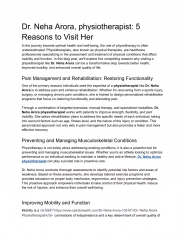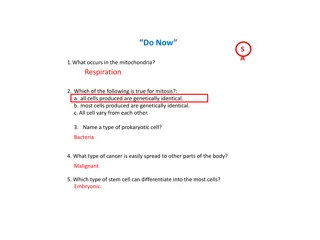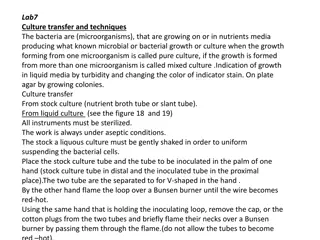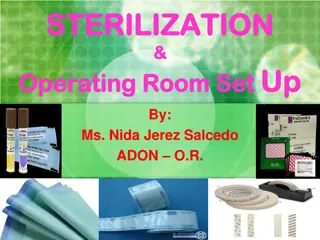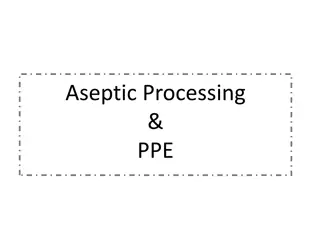Comprehensive Guide to Aseptic Gowning by Dr. Chander Arora
Explore a detailed overview of aseptic gowning practices by Dr. Chander Arora, covering topics such as definitions, purposes, good practices, and step-by-step guidelines for proper gowning levels. Learn the importance of maintaining cleanliness, using personal protective equipment, and following FDA standards. Ensure a thorough understanding of aseptic techniques to uphold safety and quality standards in various industries.
Download Presentation

Please find below an Image/Link to download the presentation.
The content on the website is provided AS IS for your information and personal use only. It may not be sold, licensed, or shared on other websites without obtaining consent from the author.If you encounter any issues during the download, it is possible that the publisher has removed the file from their server.
You are allowed to download the files provided on this website for personal or commercial use, subject to the condition that they are used lawfully. All files are the property of their respective owners.
The content on the website is provided AS IS for your information and personal use only. It may not be sold, licensed, or shared on other websites without obtaining consent from the author.
E N D
Presentation Transcript
Aseptic Gowning DR. CHANDER ARORA
Introduction to Aseptic Gowning Full Gown Gloves Masks Dr. Chander Arora - Aseptic Gowning
Aseptic Gowning - Objectives Review the aseptic gowning practices Understand proper cleanroom behaviors and the consequences of improper behaviors Provide opportunity to experience aseptic gowning Dr. Chander Arora - Aseptic Gowning
Definitions Aseptic completely clean; free of contaminants Gowning the act of putting on a coverall and related protective devices PPE Personal Protective Equipment such as eye protection, and gloves, intended to protect the operator Dr. Chander Arora - Aseptic Gowning
Purpose of Aseptic Gowning Required by the Food and Drug Administration (FDA) Provides a barrier between people and product Acts as a filtration system Part of a Good Manufacturing Practices (GMP) standard Dr. Chander Arora - Aseptic Gowning
Good Practices Begin at Home Personal Hygiene Bathe daily Wash hands after restroom use Wash hands before and after eating Wear clean clothing Keep fingernails short and clean Good skin care keep skin moisturized Dr. Chander Arora - Aseptic Gowning
Before you Gown Remove jewelry and watches that could interfere with protective garments No bare skin below the waist No nail polish or false fingernails No cosmetics, colognes, lotions, or similar products Communicate illness/health conditions with supervisor Dr. Chander Arora - Aseptic Gowning
Level I Gown Scrubs Hair net Beard cover (if needed) Safety Glasses Gloves Shoe covers Plant Shoes Dr. Chander Arora - Aseptic Gowning
Level II Gowning Scrubs Hair net Beard cover (if needed) Safety Glasses Gloves Shoe covers Plant Shoes Hood Facemask Coverall Shoe Covers Sterile Gloves Dr. Chander Arora - Aseptic Gowning
Level III Gowning Scrubs Hair net Beard cover (if needed) Safety Glasses Gloves Shoe covers Plant Shoes Hood Facemask Coverall Shoe Covers Sterile Gloves Sterile Sleeves Sterile Gloves Dr. Chander Arora - Aseptic Gowning
Where to turn to for help In the processing facility, you will be assisted by: Signage on proper donning and doffing procedures Mirrors so you can check your work! Each other if you notice someone's gown is improperly worn, let them know YOU are responsible for gowning properly. Dr. Chander Arora - Aseptic Gowning
Aseptic Gowning Activity GOWNING PRACTICE Dr. Chander Arora - Aseptic Gowning
Changing Gowning Change garments: When the garment is wet When the garment is torn After you sneeze Change sterile gloves if they tear. Dr. Chander Arora - Aseptic Gowning
Cleanroom Behaviors Cleanroom Behaviors impact the aseptic environment. Body regenerative processes skin flakes, oils, perspiration, hair Movement Attitude Dr. Chander Arora - Aseptic Gowning
Movements that can cause contamination Moving quickly Sneezing Coughing Excessive perspiration Personal contact Horseplay Activity Particles/minute (.3 microns and larger) MOTIONLESS (STANDING OR SITTING) 100,000 Walking 2MPH 5,000,000 WALKING 3.5 MPH 7,000,000 WALKING 5 MPH 10,000,000 HORSEPLAY 100,000,000 Dr. Chander Arora - Aseptic Gowning
Prohibited Actions in the Cleanroom Eating Drinking Scratching Waving Chewing Exposed skin Touching another person Removing gowning or PPE Folding hands or arms Cell phones Listening to music Dr. Chander Arora - Aseptic Gowning
Prohibited Actions: Eating and Drinking Dr. Chander Arora - Aseptic Gowning
Prohibited Actions: Scratching & Touching Scratching your body Touching face or any exposed skin Especially around eyes, nose and mouth Dr. Chander Arora - Aseptic Gowning
Attitude Our approach, or attitude, may determine whether we prevent contamination or allow contamination. Work habits Communication Stop and think Dr. Chander Arora - Aseptic Gowning
Review Review of Objectives: Understand the aseptic gowning sequence Understand proper cleanroom behaviors and know the consequences of improper behaviors Accept cleanroom responsibilities as YOUR responsibility Dr. Chander Arora - Aseptic Gowning





